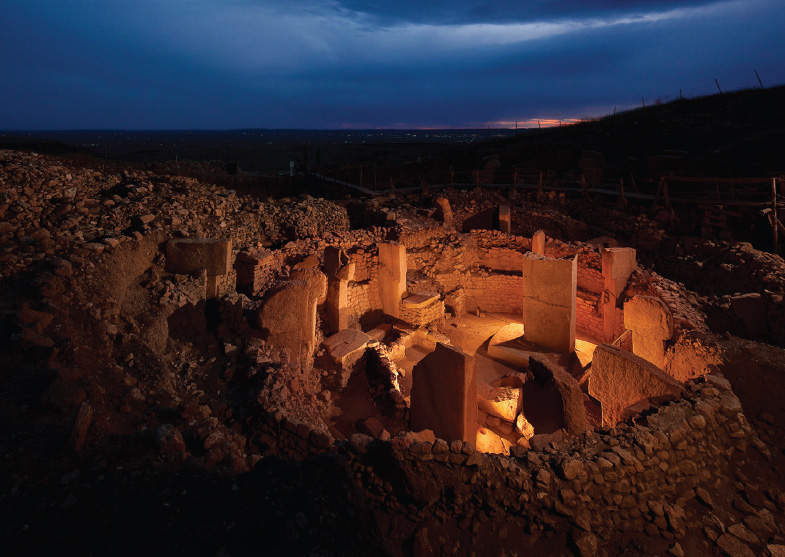Settling Down: The Great Transition
Change
Question
M/T83sI4svBa43qUgbxbewfsU5W7/CwzHdpwmWI9lttWoFnlBQT1HdLu7z4m39g7LjquGVNKpaw/LTiOYkShnoY7HZCDmPOdhcodXHZbJ7SR0hu6loM96qIaD3MWOqcuwF4dZZJav7xQLB4k3n8y7ZFOa6PRdpmRWztJSg==[Answer Question]
Though glacially slow by contemporary standards, changes in Paleolithic cultures occurred over time as people moved into new environments, as populations grew, as climates altered, and as different human groups interacted with one another. For example, all over the Afro-Eurasian world after 25,000 years ago, a tendency toward the miniaturization of stone tools is evident, analogous perhaps to the miniaturization of electronic components in the twentieth century. Known as micro-blades, these smaller and more refined spear points, arrowheads, knives, and scrapers were carefully struck from larger cores and often mounted in antler, bone, or wooden handles.17 Another important change in the strategies of Paleolithic people involved the collection of wild grains, which represented a major addition to the food supply beyond the use of roots, berries, and nuts. This innovation originated in northeastern Africa around 16,000 years ago.
But the most striking and significant change in the lives of Paleolithic peoples occurred as the last Ice Age came to an end between 16,000 and 10,000 years ago. What followed was a general global warming, though one with periodic fluctuations and cold snaps. Unlike the contemporary global warming, generated by human activity and especially the burning of fossil fuels, this ancient warming phase was a wholly natural phenomenon, part of a long cycle of repeated heating and cooling characteristic of the earth’s climatic history. Plants and animals unable to survive in the Ice Age climate now flourished and increased their range, providing a much richer and more diverse environment for many human societies. Under these improved conditions, human populations grew, and some previously nomadic gathering and hunting communities, but not all of them, found it possible to settle down and live in more permanent settlements or villages. These societies were becoming both larger and more complex, and it was less possible to simply move away if trouble struck. Settlement also meant that households could store and accumulate goods to a greater degree than previously. Because some people were more energetic, more talented, or luckier than others, the thin edge of inequality gradually began to wear away the egalitarianism of Paleolithic communities.
Changes along these lines emerged in many places. Paleolithic societies in Japan, known as Jomon, settled down in villages by the sea, where they greatly expanded the number of animals, both land and marine, that they consumed. They also created some of the world’s first pottery, along with dugout canoes, paddles, bows, bowls, and tool handles, all made from wood. A similar pattern of permanent settlement, a broader range of food sources, and specialized technologies is evident in parts of Scandinavia, Southeast Asia, North America, and the Middle East between 12,000 and 4,000 years ago. In Labrador, longhouses accommodating 100 people appear in the archeological record. Far more elaborate burial sites in many places testify to the growing complexity of human communities and the kinship systems that bound them together. Separate cemeteries for dogs suggest that humankind’s best friend was also our first domesticated animal friend.

Among the most stunning and unexpected achievements of such sedentary Paleolithic people comes from the archeological complex of Göbekli Tepe (goh-BEHK-lee TEH-peh) in southeastern Turkey, under excavation since 1994. Dating to 11,600 years ago, it consists of massive limestone pillars, some weighing as much as sixteen tons, which were carved in a T shape and arranged in a set of some twenty circles or rings. Gracefully carved animals—gazelles, snakes, boars, foxes—decorate the pillars. Göbekli Tepe was probably a ceremonial site, for little evidence of human habitation has been found. Those who constructed or staffed the complex dined on animals hunted at a distance. Dubbed the “world’s oldest temple,” Göbekli Tepe was the product of people practicing a gathering and hunting way of life though living at least part of the year in settled villages. It represents a kind of monumental construction long associated only with agricultural societies and civilizations.18
Studies of more recent gathering and hunting societies, which were able to settle permanently in particular resource-rich areas, show marked differences from their more nomadic counterparts. Among the Chumash of southern California, for example, early Spanish settlers found peoples who had developed substantial and permanent structures accommodating up to seventy persons, hereditary political elites, elements of a market economy including the use of money and private ownership of some property, and the beginnings of class distinctions.
SUMMING UP SO FAR
Question
gbWPtGeAG9VH4epJuOixfltmFgYQ7N/YT9wXNr0o0Jp5LI+7kd80vT6lwTrZ8RFp2dr142OBgz1aUXyc42aj+Q1OcqlgfFS0U5p4hg0p61aSPrLSHpIHCbPpju0rIq3q9EpTWt8wTkKD+1xf74N6QaE/fB3LdZKFNlF5PQ==[Answer Question]
This process of settling down among gathering and hunting peoples—and the changes that followed from it—marked a major turn in human history, away from countless millennia of nomadic journeys by very small communities. It also provided the setting within which the next great transition would occur. Growing numbers of men and women, living in settled communities, placed a much greater demand on the environment than did small bands of wandering people. Therefore, it is perhaps not surprising that among the innovations that emerged in these more complex gathering and hunting societies was yet another way for increasing the food supply—agriculture.
Snapshot: Paleolithic Era in Perspectivefn:1_16
| Paleolithic Era (from 250,000 to 10,000 years ago) | Agricultural Era (from 10,000 to 200 years ago) | Modern Industrial Era (since 1800) | |
|---|---|---|---|
| Duration of each era, as a percentage of 250,000 years | 96% | 4% | 0.08% |
| Percent of people who lived, out of 80 billion total | 12% | 68% | 20% |
| Percent of years lived in each era (reflects changing life expectancies) | 9% | 62% | 29% |